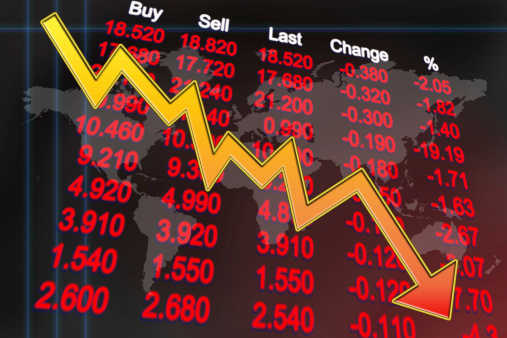May has come and gone, and at least so far it looks as though the “Sell in May and Go Away!” theme did not materialize in 2014. Of those who responded to our poll, some 58% said not to sell in May and only 27% said to sell. The S&P 500 Index hit a new all-time high at the end of May. So, what do investors do if they are nervous that a peak has come? Worse, what if the stock market were to crash?
24/7 Wall St. has made a mid-2014 assessment of the markets for investors who want to stay in longer but who also want to not get caught if the stock market suddenly plunges.
Most investors make money in up-markets, but even most equity hedge funds and professional money managers lose money in down markets. The real question that needs to be asked now is how to protect your money against a market crash, while still looking for upside if the bull market continues its charge in 2014.
What if stocks fall 10%, or 20%, in a short time? Many market pundits have said that the stock market needs to sell off — and we have not had a major pullback in more than two years. The bottom of the market was back in March of 2009, so we are 63 months into the rally, and the S&P 500 is nearing a 200% gain from that March 2009 low.
A 10% drop is considered a market correction. A 20% correction would be back in bear market territory again. If either comes about, the doomsday financial market pundits would get to be relevant again. So, what are some strategies to avoid a major bear market for investors who still want upside from stocks?
Here are 11 quick hit strategies that investors can use to shield themselves from a stock market crash while keeping their toes in the water if the rally continues.
1. Take Some Profits Off the Table!
Many market pundits gave 1,900 to 2,000 as their S&P 500 price targets for 2014 or 2015. The S&P 500 was above 1,920 on late Friday, and the Dow Jones Industrial Average (DJIA) was challenging 16,700. If you want to keep your assets in the market for upside but are worried about downside, you can start shaving off part of your positions in your portfolio. You will have some great gains that can be locked in, and you will force yourself into taking profits with the market at all-time highs. You can start by trimming 10% to 25% off of your positions. This locks in profits, and it gives you new cash to buy new stocks you wanted to own at lower prices if that correction really comes.
2. Put Options Are Your Friend!
One very easy strategy to lock in gains is to buy options. You can buy them against the S&P 500, the DJIA, or likely on just about any large cap stock you own. The good news here is that you can lock in your downside (or lock in your upside) by picking a strike price that is 5% or 10% under the current price. And you can pick any month of expiration that you want as well. Buying put options is a simple way of downside protection — think of it as insurance on your portfolio.
3. Write Call Options … And Make Even More Money!
One tool that many investors use to drive their returns higher through time is by writing call options. This forces a sale if the stock rises, and your effective sale price becomes the strike price plus whatever premium you receive from selling the call option. Some investors do this with their stock holdings each and every month or quarter. In this case you are forced out of your shares if they move up more than you expected, and you collect income from writing that option too.
ALSO READ: Top Stocks That Will Benefit From Aging America
4. Collars Are Not Just For Your Pets!
One strategy that investors do not use as often as they should is the “costless collar.” This is letting someone else pay for your portfolio insurance, and a blend of puts and calls from above. It is cheaper than paying the higher costs of insuring your whole portfolio. A costless collar strategy is one in which investors sell call options on their stocks and simultaneously buying “out of the money” S&P 500 index puts with the call option premium collected.
5. Remember Inverse or Short-Selling ETFs?
If investors want to shield themselves from a market correction, or crash, they can always buy the short-selling exchange traded funds (ETFs). For the S&P 500, there is the ProShares Short S&P 500 (NYSEMKT: SH), which is simply the inverse of the S&P 500. Then there is the Pro Shares UltraPro Short S&P 500 (NYSEMKT: SPXU) ETF, which is actually two times short the S&P 500. Just keep in mind that short ETFs might not replicate the exact downside of the market. One other option is the AdvisorShares Ranger Equity Bear ETF (NYSEMKT: HDGE), which acts like a short-only hedge fund. This one actively screens for over-sauced stocks that have accounting and business weakness.
6. Play the Short Game Yourself!
If you want to keep upside in your existing portfolio but think stocks are getting too juicy, then you can start selecting a basket of stocks that you think would be vulnerable if the market sells off much. Then you can short sell these stocks. Just always keep in mind that you have unlimited downside when you are short a stock. There is a reason that short selling is often avoided by the public, and why so few people actually short sell.
7. Rotate and Look for Dividends!
So you have great gains in your major industrials, biotechs, financials and tech stocks. One way to keep upside in the stock market without taking too much implied risk ahead is to rotate out of your growth stocks into defensive stocks. These would be sectors such as boring consumer products, food and beverage, utilities, tobacco and maybe Big Pharma stocks. Generally these will come with higher dividends than other stocks. Still, which stock will fall more in a market correction: Merck or Amgen?
ALSO READ: Nasdaq Stocks With the Most Short Interest
8. Focus on Buybacks!
Many investors have decided to focus on stocks that consistently keep buying back their shares. We have often seen solid buybacks outperform dividends in ETFs. One such ETF would be the AdvisorShares TrimTabs Float Shrink ETF (NYSEMKT: TTFS), which selects buybacks that are aimed at true float contraction. Then there is the much more liquid and better known PowerShares Buyback Achievers (NYSEMKT: PKW) ETF. This returned 45.5% to investors in 2013, compared with about 30% for the S&P 500.
9. Limit Yourself!
Many investors worry that if they set limit orders their stocks will magically fall to that level and then turn around. That can happen in a flash crash, but it is unlikely to happen to every stock in a diversified portfolio at once. You can set up limit orders that would lock in a sale at a fixed price, and you can do that if the bid falls under a certain price OR if the price rises above a certain level. How do you think fund managers and their teams go on vacation with very few people in the office around holidays? They often preset buy and sell orders based around price limits and stop loss orders. If you are too scared to do this, then you can even create mental sell limits — but you better make a written contract with yourself to make you live up to it if and when a level is hit.
10. Get a Conservative Financial Advisor!
Many investors have taken the do-it-yourself route for a long time now. Some investors bought at the top in 2007 and sold into the crash in late 2008 and early 2009, feeling a bit silly. Turning your assets over to a professional may shield you from your own mistakes. Just don’t forget what we said earlier – most financial advisors and fund managers also lose money in down markets. Some people just feel better turning decisions over to others, even if it means that they might not pay only $9.95 per transaction thereafter.
ALSO READ: Seven States Running Out of Water
11. Follow Old People — Into Bonds!
It was a real struggle to include bond buying as a strategy in 2014 to protect against a market crash. After all, market pundits almost unanimously agree that interest rates should rise in 2015 and beyond. That will not be good for bonds. One strategy is to just stick with lower duration notes, say five-year Treasuries and shorter. You can even make a whole 1.5% per year on a five-year Treasury note (oh joy!). If that is too low, you can buy tax-free municipal bonds or high-grade corporate bonds too. The returns on short duration bonds are just so low that you will not even know they are there, but sometimes that safety of principal outweighs the desire to make returns on top of principal.
Take Charge of Your Retirement In Just A Few Minutes (Sponsor)
Retirement planning doesn’t have to feel overwhelming. The key is finding expert guidance—and SmartAsset’s made it easier than ever for you to connect with a vetted financial advisor.
Here’s how it works:
- Answer a Few Simple Questions. Tell us a bit about your goals and preferences—it only takes a few minutes!
- Get Matched with Vetted Advisors Our smart tool matches you with up to three pre-screened, vetted advisors who serve your area and are held to a fiduciary standard to act in your best interests. Click here to begin
- Choose Your Fit Review their profiles, schedule an introductory call (or meet in person), and select the advisor who feel is right for you.
Why wait? Start building the retirement you’ve always dreamed of. Click here to get started today!
Thank you for reading! Have some feedback for us?
Contact the 24/7 Wall St. editorial team.





